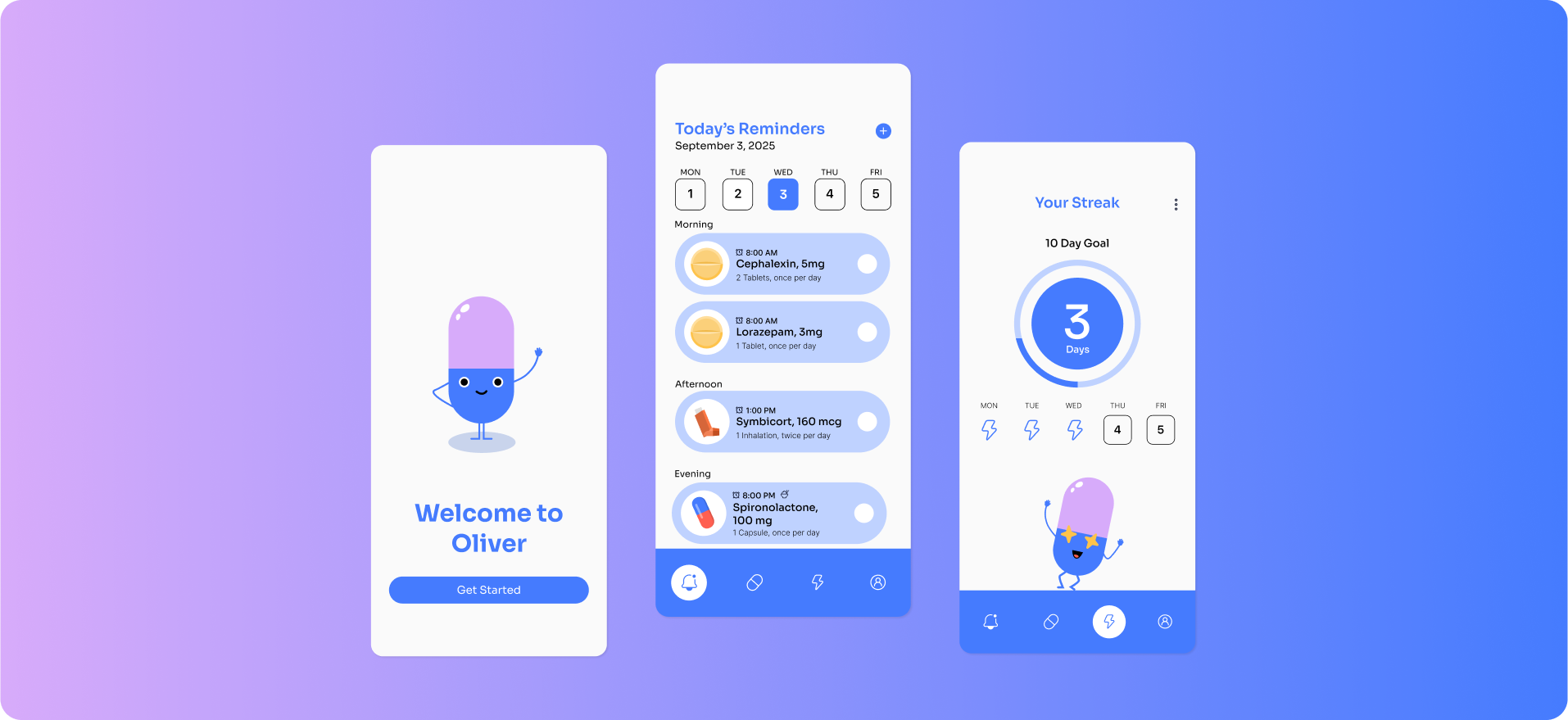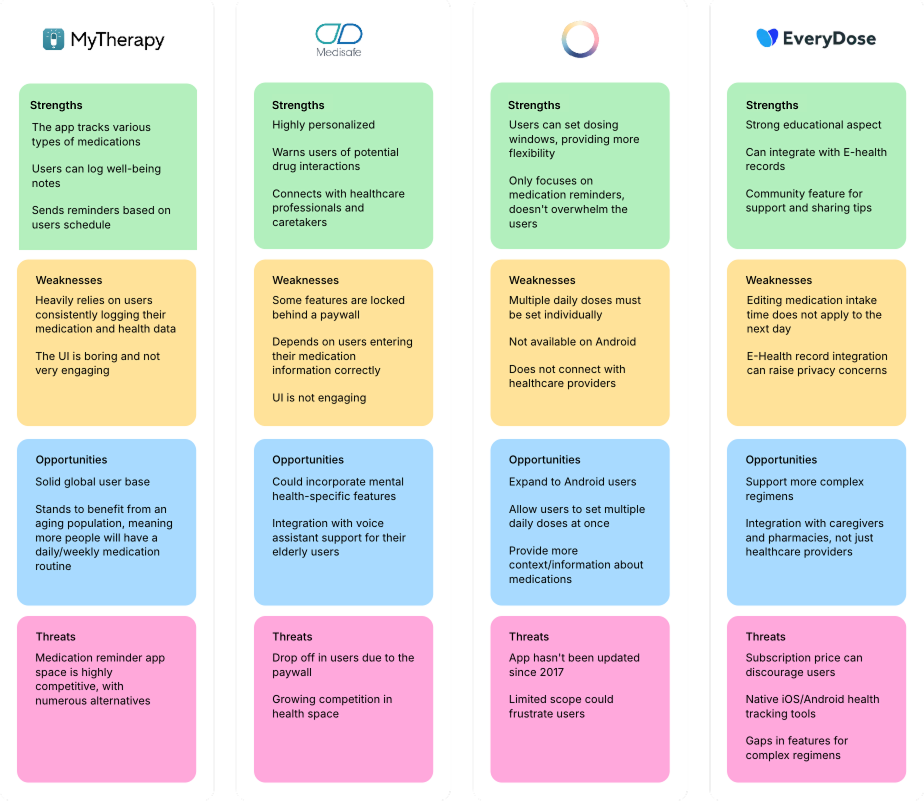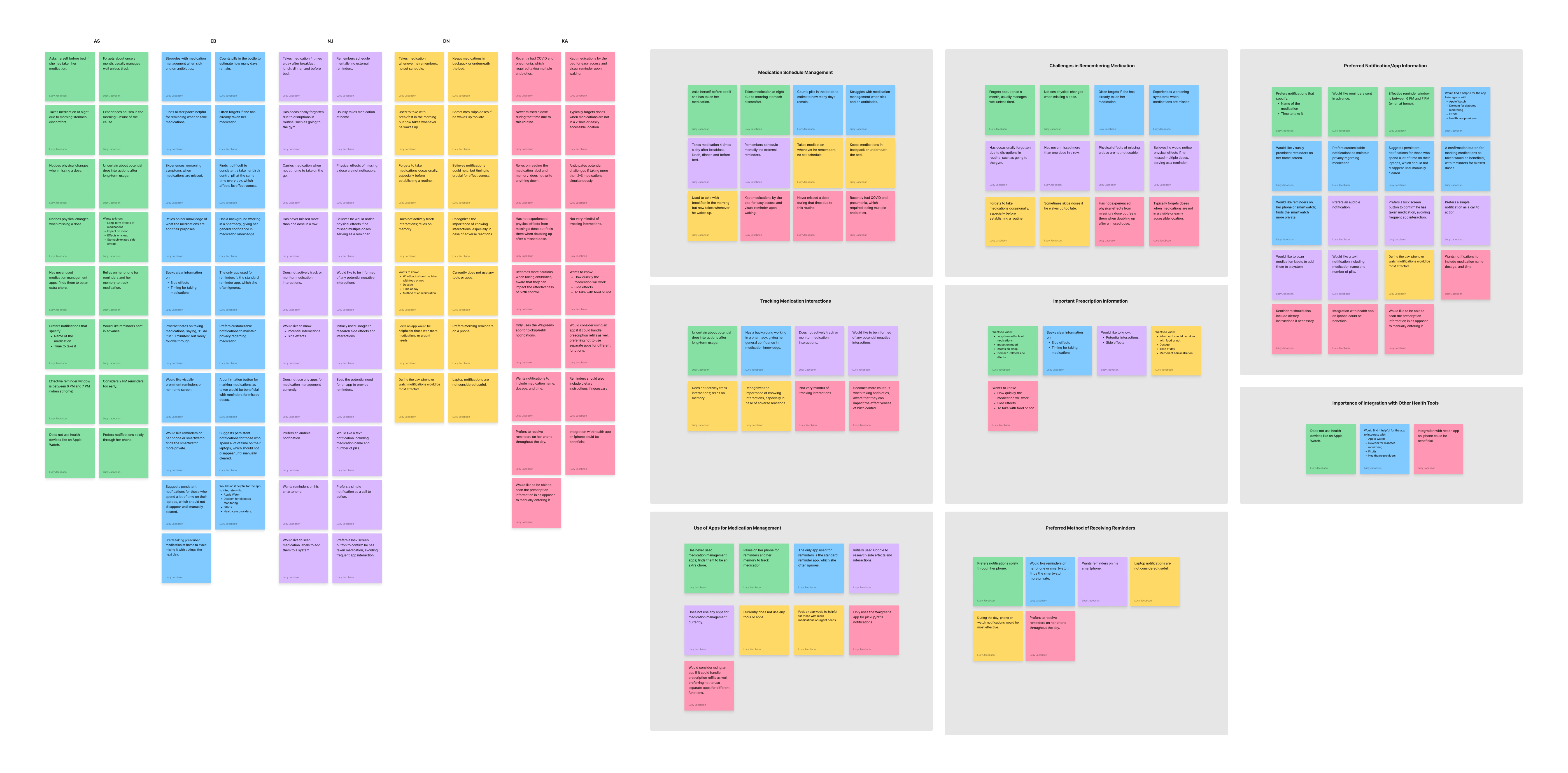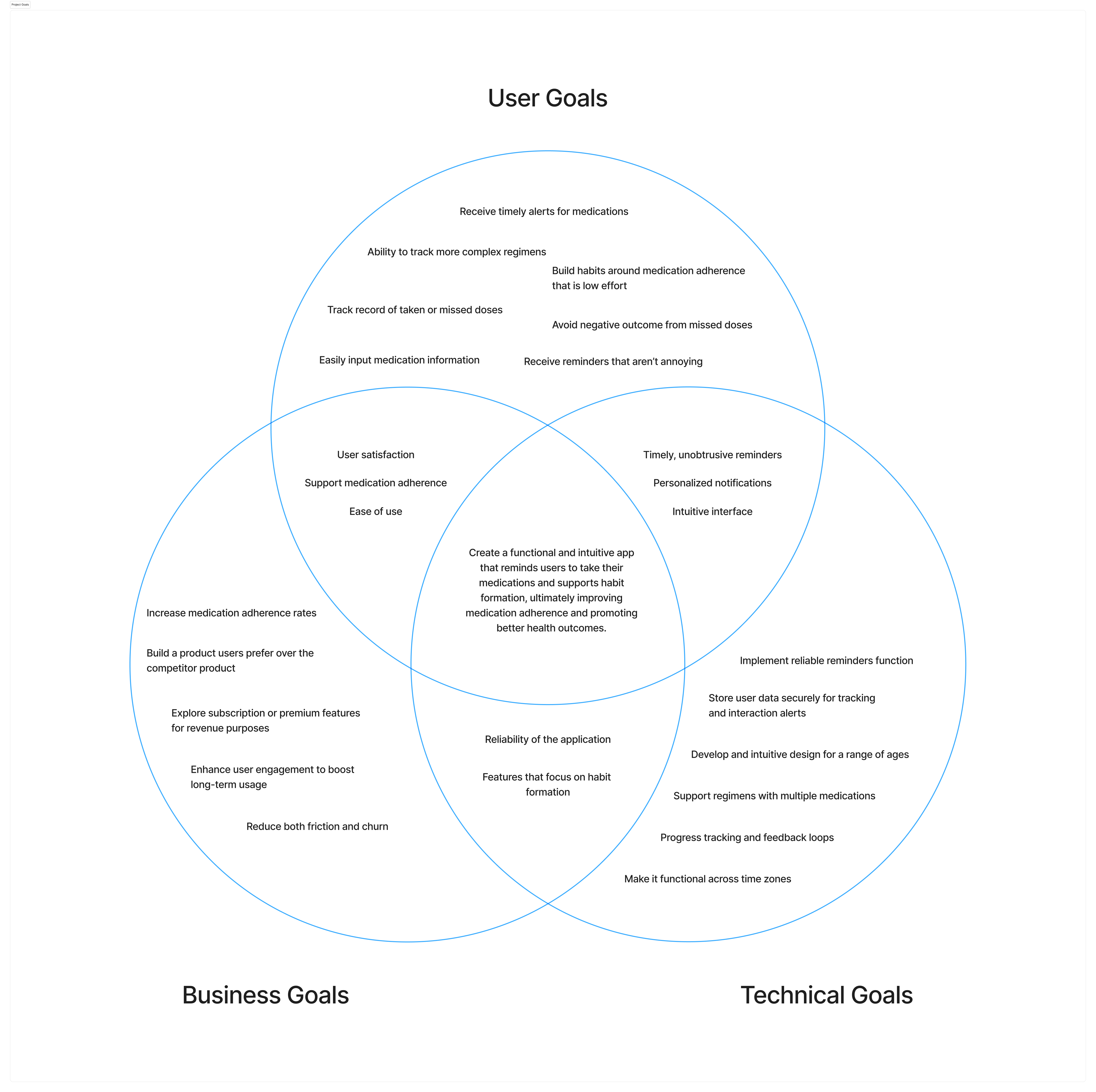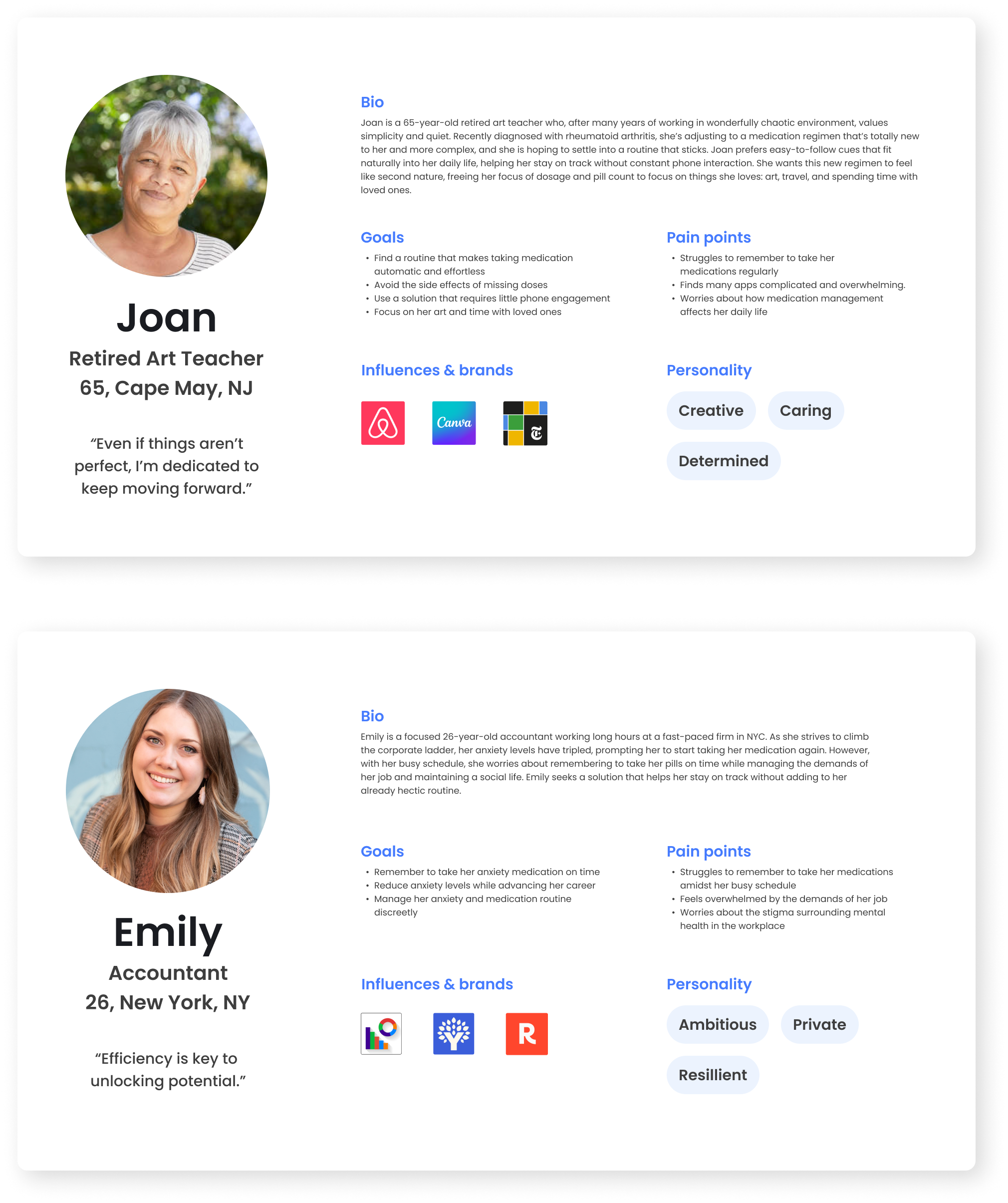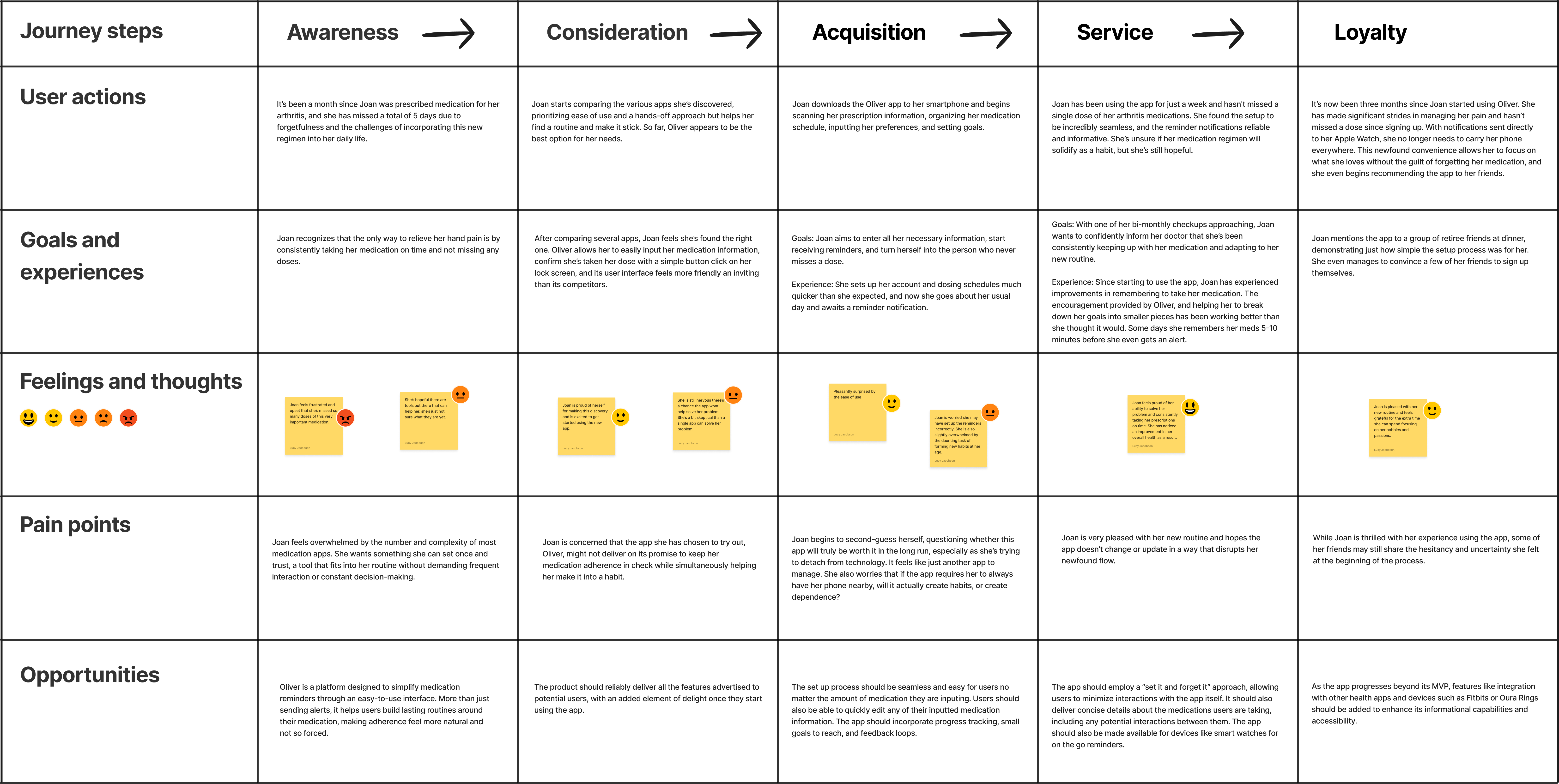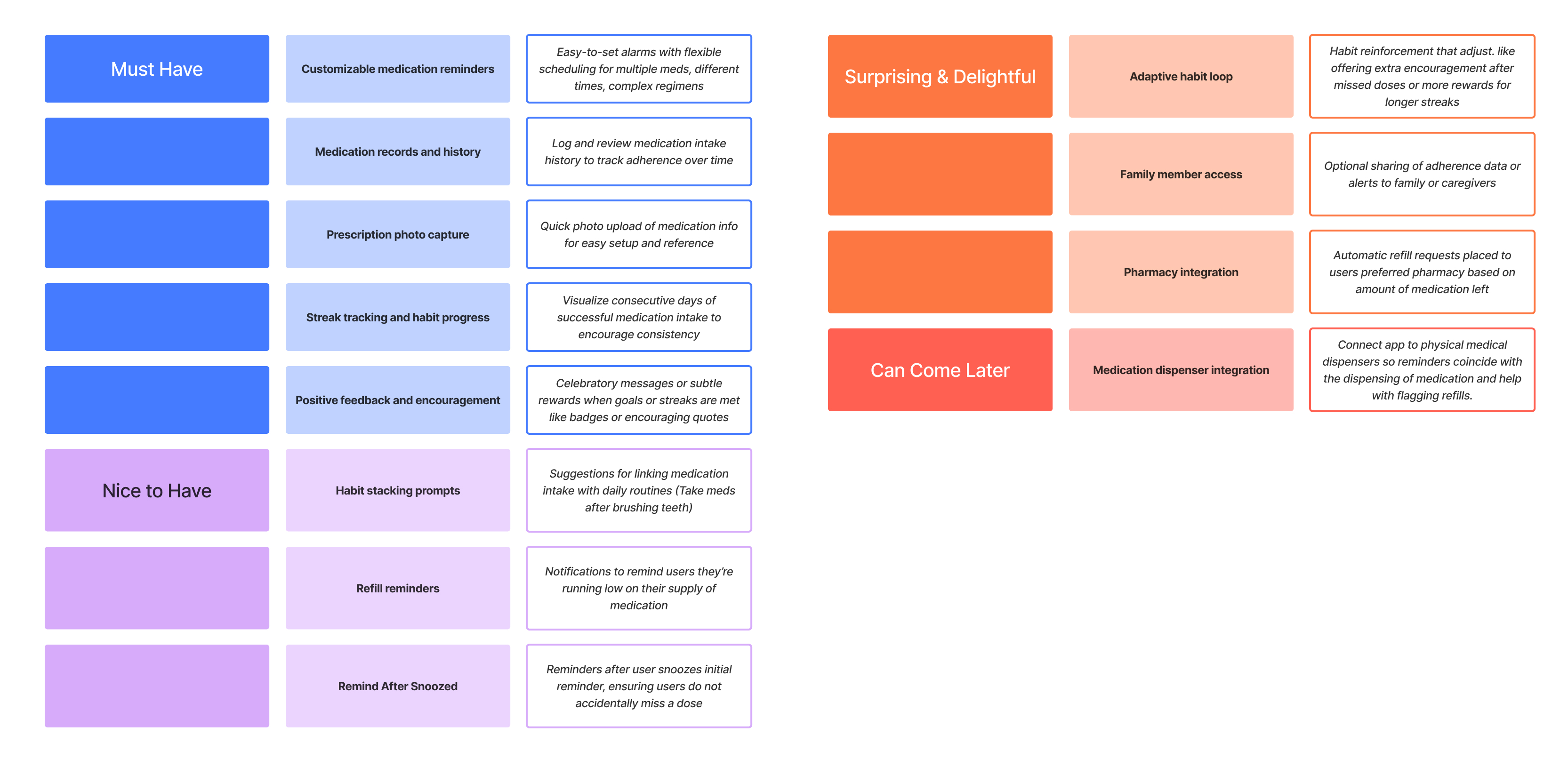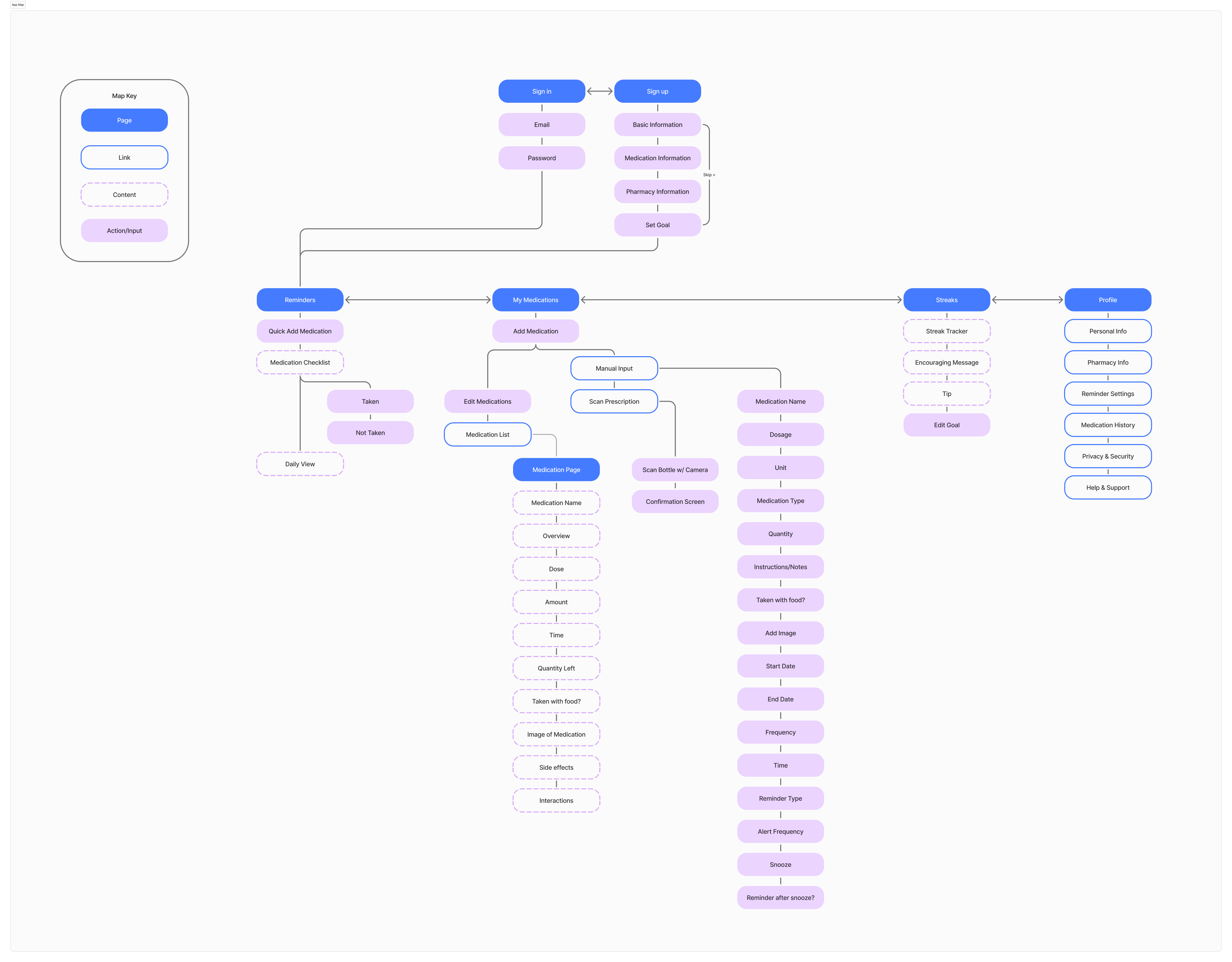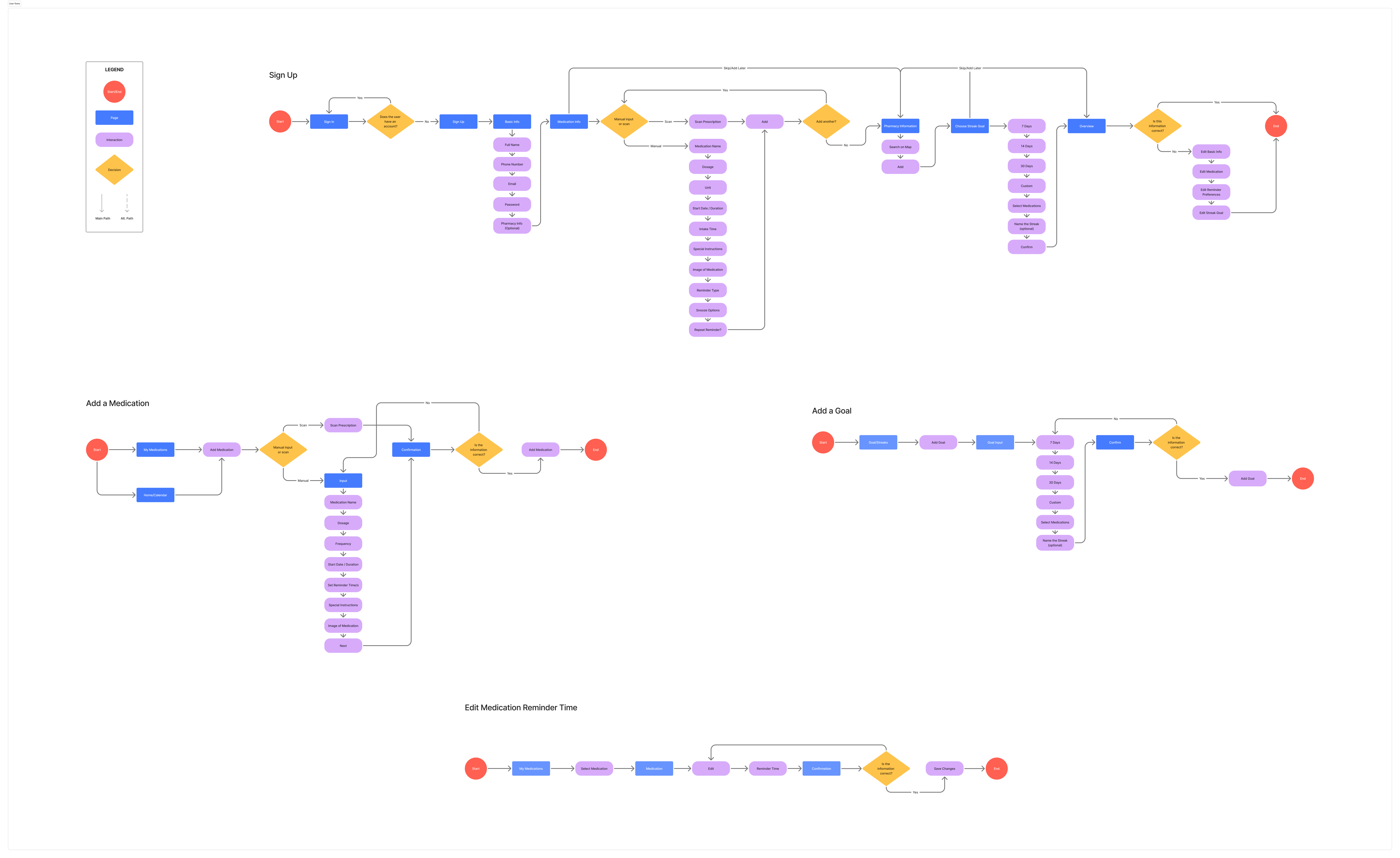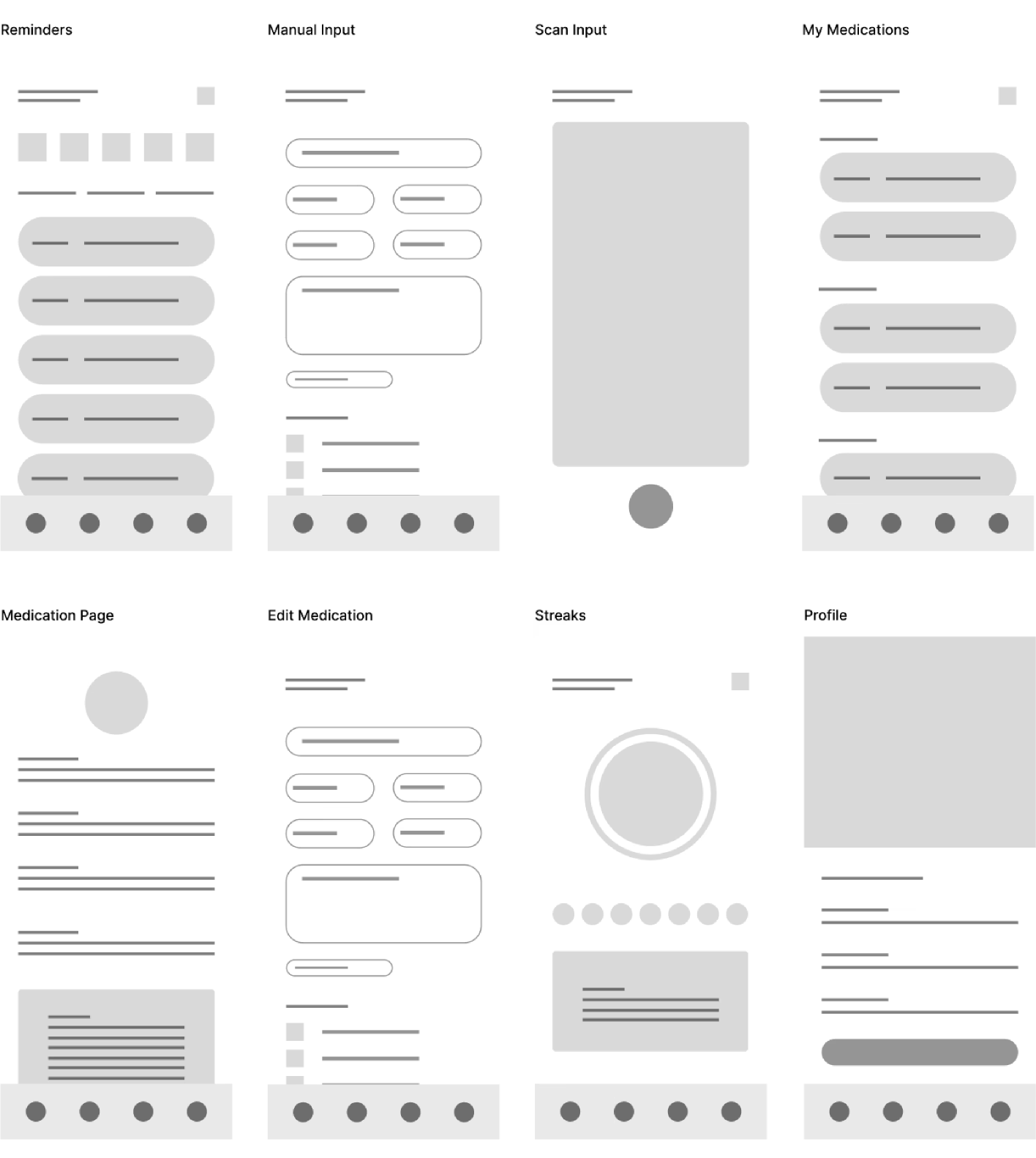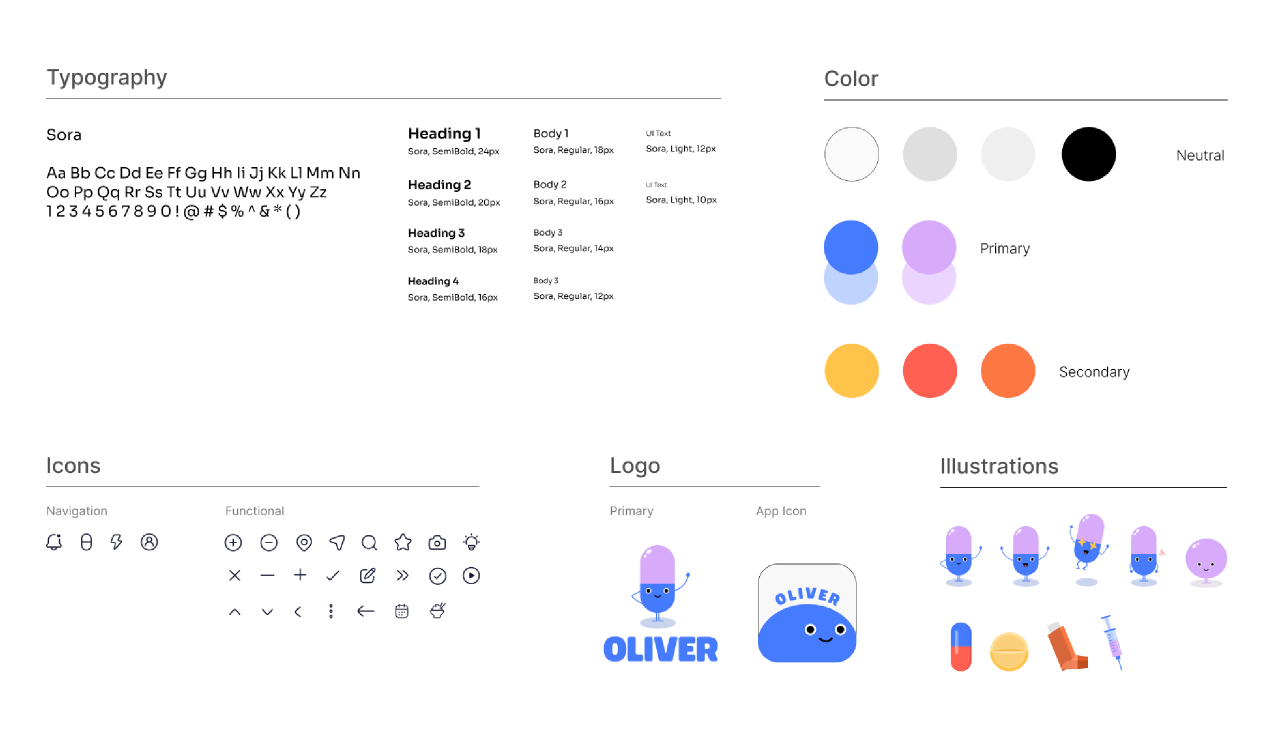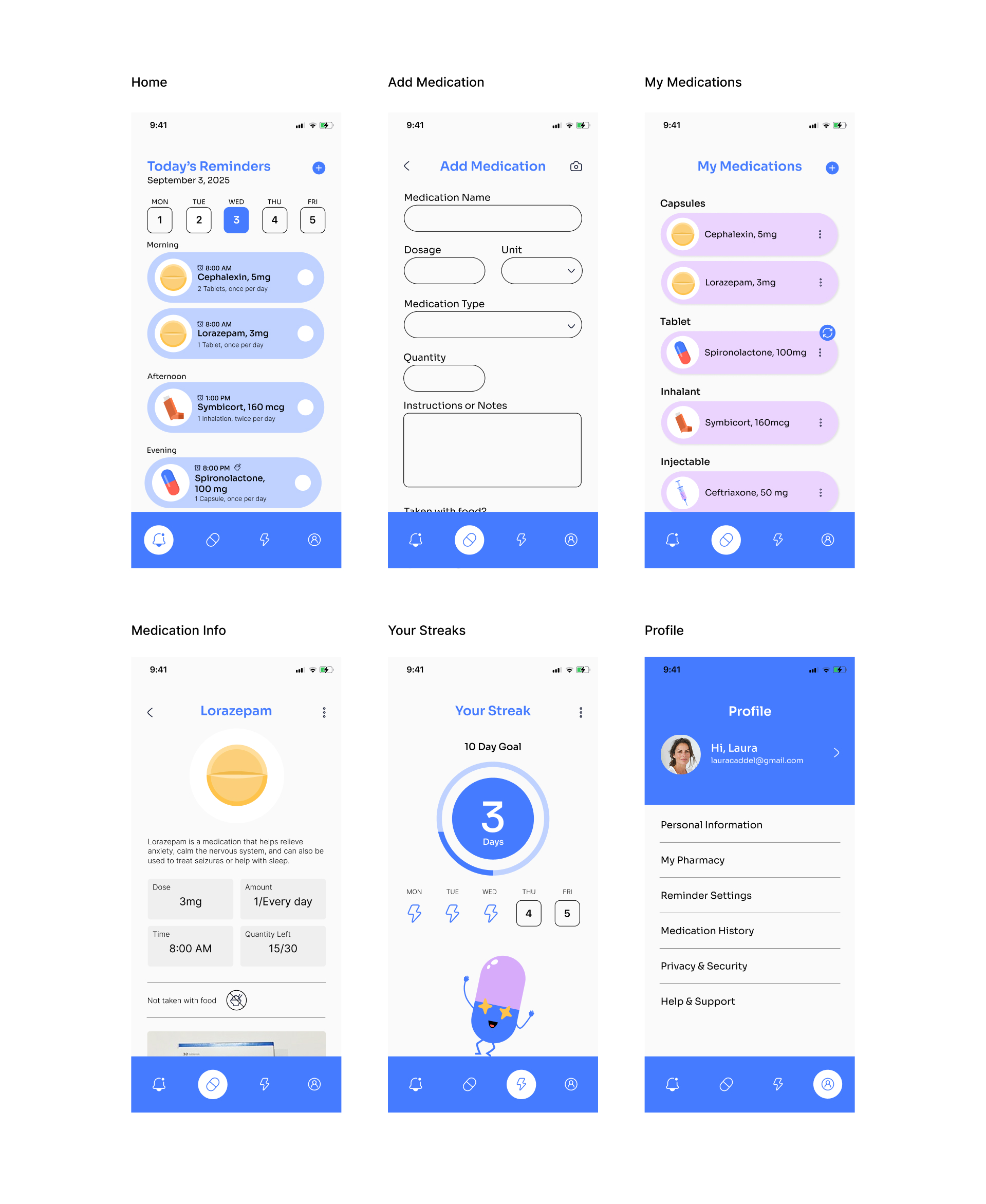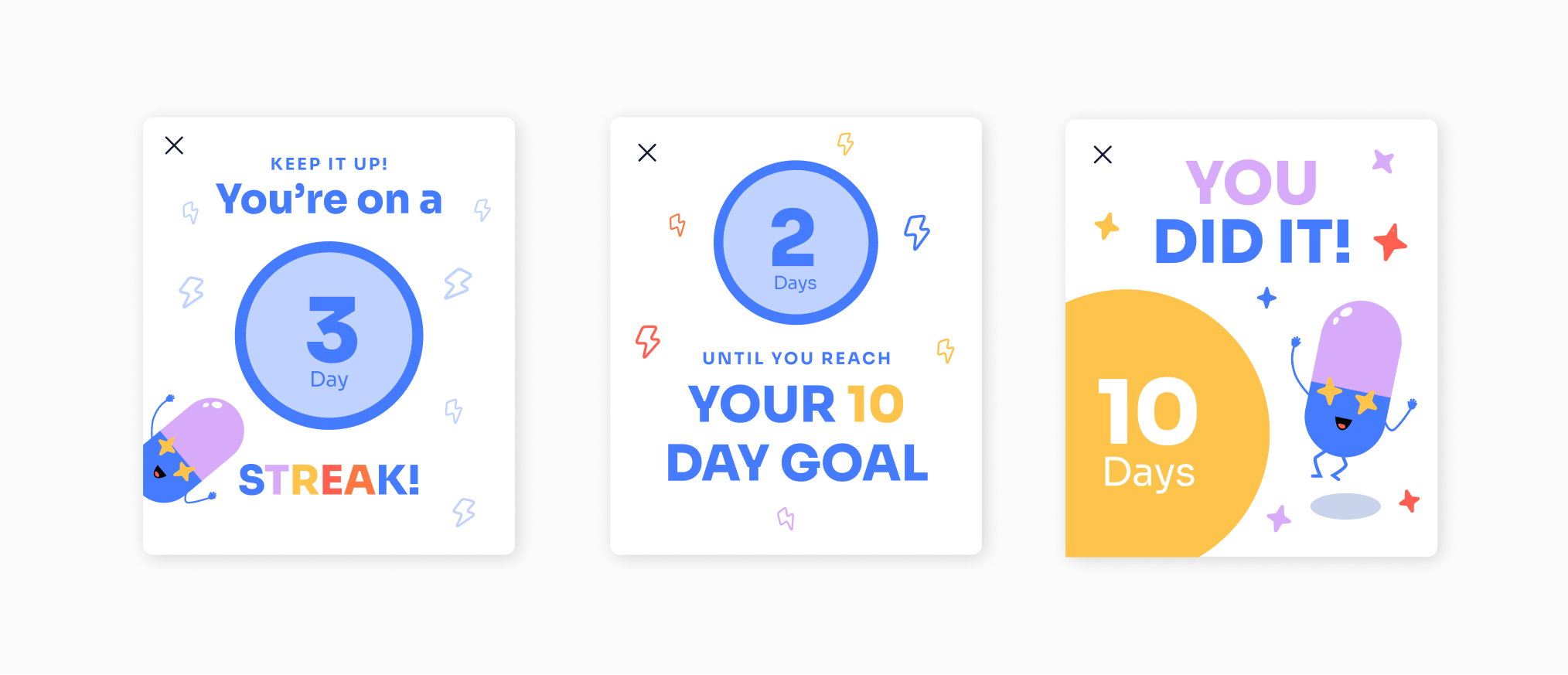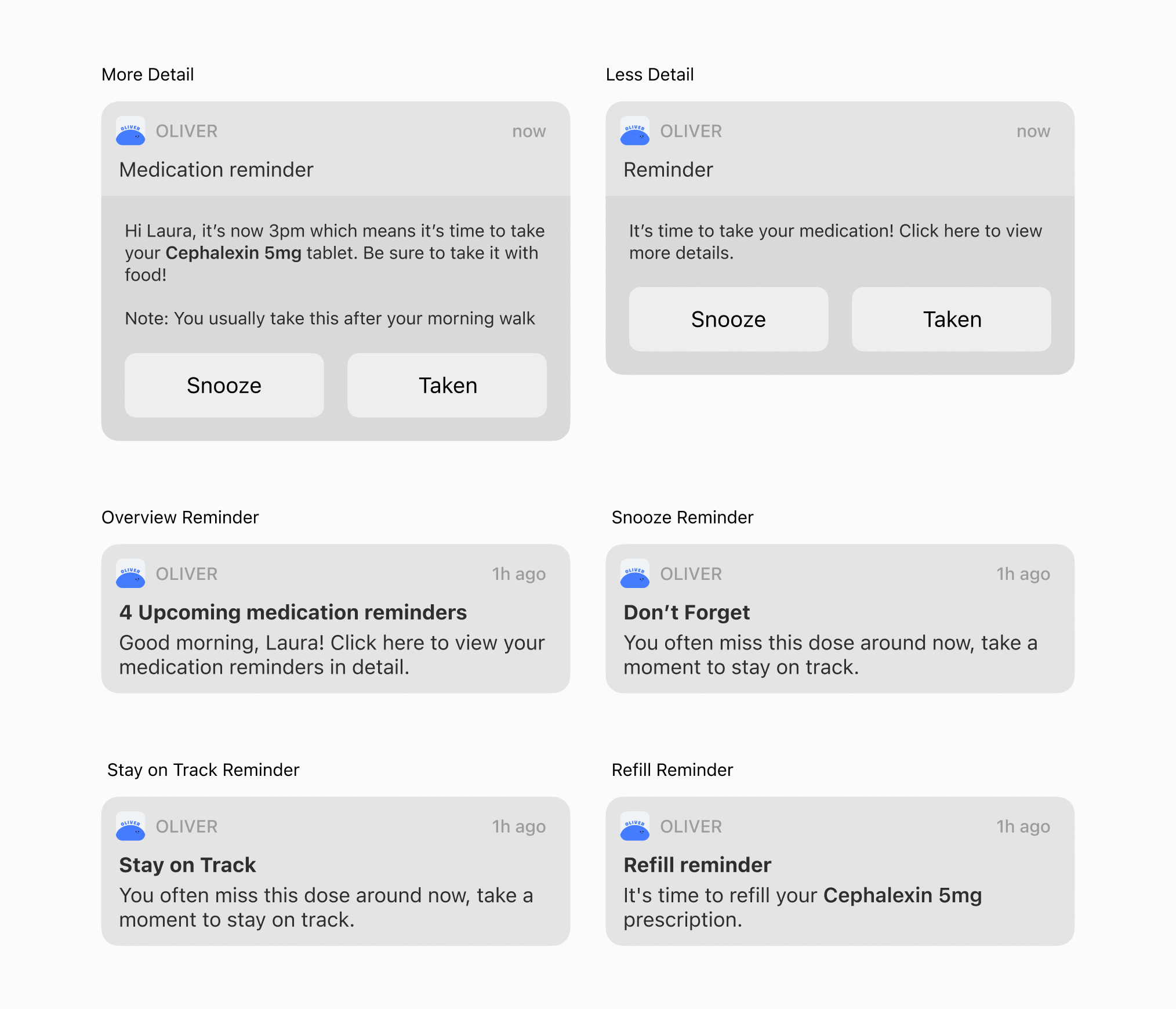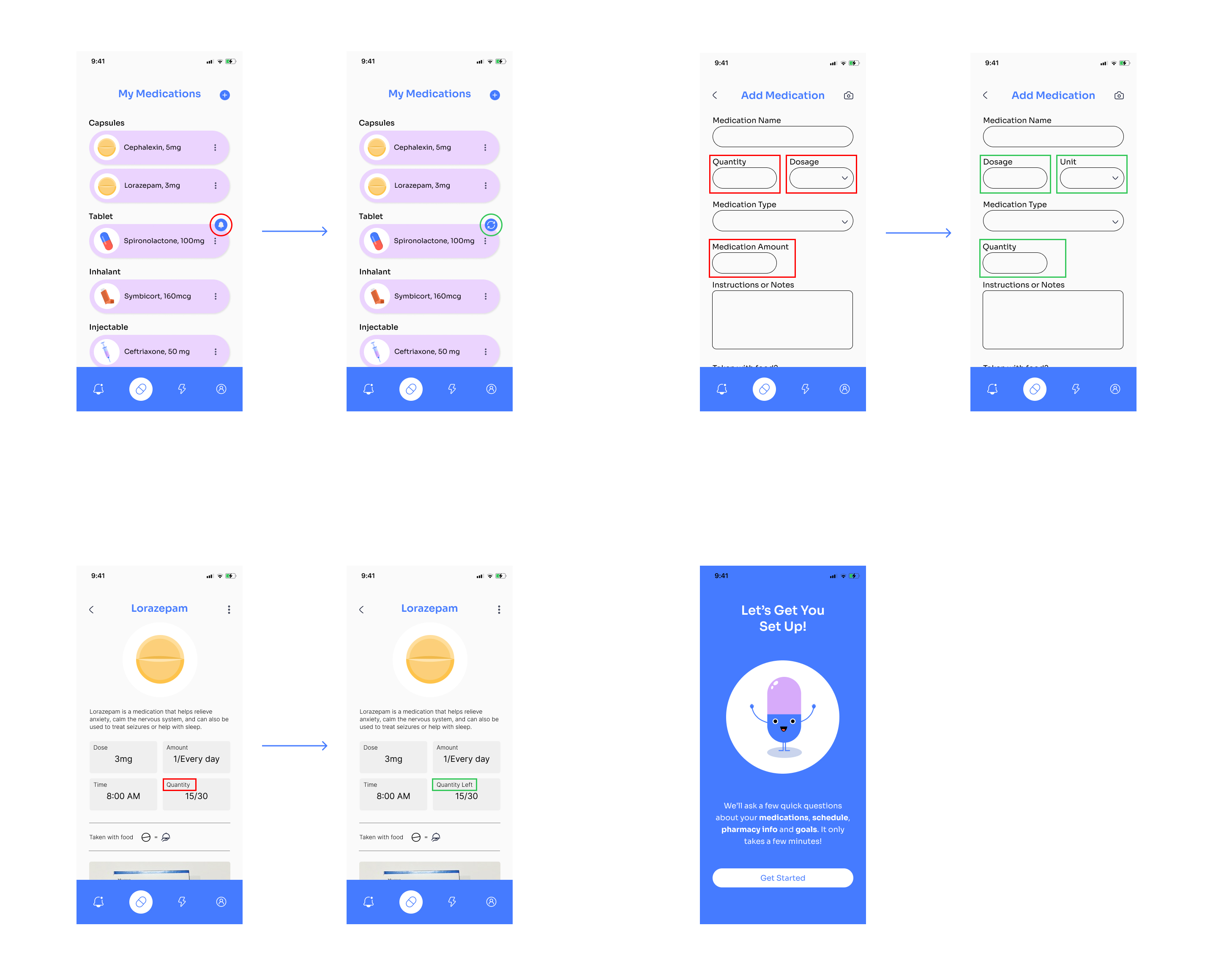OLIVER
An app designed to help users manage their daily medication
regimen by sending reminders for when to take their doses. It also provides information about potential side
effects and interactions with other medications so users can stay informed and never miss a dose.
(Student project)
ROLE
Product Designer
TIMELINE
1 month
* Part-time
20hr/week schedule
PROBLEM
Medication Adherence Matters
Everyone forgets to take their medication at some point, some more often than others. Sometimes, missing a dose can result in a longer recovery time. Other times, consequences can be more extreme. For example, if people with Parkinson's disease delay their medication intake by even one hour, they can experience an immediate increase in symptoms (Grissinger, 2018). Seeing how missed doses affected loved ones with Parkinson’s showed me how important timely medication is for them and for many others with chronic conditions. That insight led me to build a simple, unobtrusive tool to help people stay on track with their treatment.
RESEARCH METHODOLOGIES
How I identified my users and their needs
This project tackles a problem I’ve seen first hand, loved ones struggling with medication adherence. But I knew there was more to the story. I spoke with people with different routines and regimens to learn why doses were being missed and why their current reminders weren’t enough. What I found was a clear gap between how people want to manage their medications and the limited, often inconvenient tools available to them. Here's how I did that:
01 COMPETITIVE ANALYSIS
A look at existing medication reminder tools
I looked into the top apps on the App Store: MyTherapy, Medisafe, RoundHealth, and EveryDose. Each had its strengths, like personalized reminders, info on drug interactions, or connecting with caregivers and healthcare providers. But many advanced features were behind paywalls, and the apps often missed out on behavioral reinforcement or follow-ups for missed reminders.
Competitive Analysis
→
×
![]()
02 USER INTERVIEWS
Why do people forget to take their medication?
I spoke with five users of different ages and medication routines. Some were only on short-term antibiotics, while others took medications up to four times a day. This variety helped me imagine an app that can meet a wide range of needs. I focused on understanding three things: behavior patterns around taking meds, pain points with current tools, and what users want to know about their medications. Since medication and health can be sensitive topics, I made sure participants knew they didn’t have to share anything they weren’t comfortable with, and that all personal details would be kept confidential.
DN
"When I get prescribed something new, I'm most curious about name, dosage, and how you take it."
AS
"I just set a reminder on my phone. Using an app feels like one more thing to do."
KA
"When remembering to take my medication it not completely obvious to me, that is when I forget."
NJ
"If I miss two doses, I’ll definitely feel it and that’s how I know I have forgotten to take them."
EB
"I'll see the notification reminder on my phone and think to myself that I'll take it in 10 minutes…then never do."
SYNTHESIS
Insights from the interviews
Throughout the interviews I noticed some patterns forming in the responses of the participants, particularly regarding the way they remembered (or didn't) to take their medications. I learned that while people are generally curious about their medications and their effects, they don't put much of a routine in place to remember to take them. Two users noted keeping their meds in places that were easily accessible to serve as a visual cue to take them, while other users primarily rely on memory alone.
Affinity Map
→
KEY TAKEAWAYS
Conclusions I drew from my research
My competitive analysis, user interviews and secondary research left me with a few key insights to consider before moving onto feature selection and designing the app itself:
Users link medication intake with key daily routines (eating breakfast, going to bed) or strategically place medication in a highly visible area to remember their doses. This can be more useful to users than apps or tools.
Users want more personalized notifications that will adapt to their routines and maintain privacy, especially around sensitive medications.
Users expressed a limited awareness about their medications and the interactions they may have with other drugs. They stated their desire to have digestible info about side effects, interactions, and safety.
The participants didn't use medication management apps. They cited friction, complexity, or redundancy with existing tools but showed openness to one that combines reminders, refills, and interaction information.
PROJECT GOALS
Defining project, user, business, and technical goals
With the insights gathered from my research, I began mapping out how to address the most prominent pain points. There were many potential directions (medication interaction and safety info, prescription refills, caregiver support), and it was easy to feel pulled in too many at once. To stay focused, I narrowed the scope to a single goal: helping users build lasting habits around medication adherence. That said, I kept in mind how other features could be integrated later to support a more holistic experience.
PROJECT GOAL
Create a functional and intuitive app that reminds users to take their medications and supports habit formation, ultimately improving medication adherence and promoting better health outcomes.
USER PERSONAS
Defining my users, their goals, and frustrations
To reflect the range of needs uncovered in research, I created two user personas: Joan, who manages a complex medication schedule, and Emily, who takes a single daily medication. Their regimens differ but they both want medication to be a background habit, not a disruption. They're looking for routines that integrate naturally into daily life with minimal phone interaction. These personas helped shape a solution that supports different lifestyles and levels of medication complexity.
CUSTOMER JOURNEY MAP
Where you can win them…or lose them
I decided to create a customer journey map to help me identify potential areas of friction for my user and how the app might fit into someone's daily life. The journey showed how you can gain confidence by remembering on your own. Small wins, like anticipating when it's time to take your medications before the notifications arrive. This map helped me visualize potential features and how they could create lasting behavioral change.
Customer Journey Map
→
POV & HMW STATEMENT
Framing the problem around habits, not just reminders
Clear patterns from my research indicated that users didn't just need reminders, but would benefit from being able to create lasting habits around taking their medication, so as not to become reliant on their mobile device and have to constantly interact with it.
POV
"I often forget to take my medication, and it feels discouraging, like I'll never build a lasting habit. I need a way to make sure I'm confidently and consistently adhering to my prescription so I have better health outcomes."
HMW
How might we help users feel more confident and consistent with taking their medication and turn reminders into long-term habits that support users' health?
WAIT A SEC!
At this point, it was clear the issue wasn't just about forgetting, it was about routine. Reminders help, but they don’t guarantee consistency. Before I moved into creating a feature set knew I needed to better understand the psychology of habits: how they're formed and what makes them stick.
FURTHER RESEARCH
The psychology of habit building
I started this research phase by looking into some academic papers about how habits form and stick. After that, I explored existing habit-building apps to see how they applied those principles in their designs. Here’s what I discovered:
Research shows that users are more likely to stay committed when they're given specific, measurable goals rather than vague advice.
Doing the same actions at the same time and place, like after breakfast or before brushing your teeth, helps habits become automatic and less dependent on reminders.
Starting with small steps and celebrating progress, like tracking streaks or giving encouragement, helps make building habits feel easier and more motivating.
- Forest uses growing trees to reinforce focused time off phones.
- Duolingo's streak system motivates daily use through progress tracking and gentle consequences.
- Habitica gamifies real-world tasks, turning habits into in-game rewards and penalties.
FEATURE SELECTION
Possible core functions
For this app, I focused on customizable reminders, easy medication input, and a habit tracker that shows progress with positive feedback. Interview participants told me these features would provide the most value right away in the MVP.
Feature Set
→
APP MAP
The structure behind the experience
This was when things started to take shape. I considered the insight from my research that people don't want to interact with an app too much, and thought of more ways/features that could automate the experience as much or as little as someone would like. For instance, scanning the medication packaging to instantly add information, integrating the app with an Apple Watch for reminders, and marking medication as taken or skipped, and the option to set goals, as some users may just want the app for reminders only.
App Map
→
USER FLOWS
Piecing it together
I created 4 user flows to visualize the main actions users will complete in the app: Signing up, adding a medication, adding a goal, and editing a reminder time. The flows helped me realize that a reminder should be directly tied to a medication. For instance, if I add Spironolactone to my medication list, I will also need to input the time I'm supposed to take it, instead of adding medications and reminders separately. The timing of the reminder can be edited in the "My Medications" page and the user will be able to set multiple reminders for the same medication, in case they want a notification before or at the time of event.
User Flows
→
LOW-FIDELITY WIREFRAMES
The skeleton of key screens
Once the app map and user flows were finished, I started working on low-fidelity screens. To handle the large amount of information, I focused on laying out each page in its simplest form. This helped keep the design moving forward while leaving room to refine the details later.
Low-Fidelity Wireframes
→
BRANDING
Defining the visual tone
I created the branding with these characteristics in mind: trustworthy, personable, friendly, reliable, empathetic, supportive, gentle, and positive. To guide my decisions, I revisited the apps from my competitive analysis to evaluate what resonated and what fell flat. Many came across as too clinical or impersonal, which I wanted to steer clear of. Instead, I focused on a more welcoming, human-centered style, using playful illustrations to give the brand some warmth and personality.
Branding
→
HIGH-FIDELITY WIREFRAMES
It all comes together
After finalizing the low-fidelity wireframes and branding, I added a mid-fidelity step to refine the content before moving on to high-fidelity design. This was when I worked on incorporating habit-building prompts, like a habit-stacking feature that links medication to daily routines, and a space for users to note where they keep their meds, such as bedside or bathroom. These small touches help users build stronger, more consistent habits.
High-Fidelity Wireframes
→
NOTIFICATIONS
Reminders and streak messages
Getting the medication information input forms down was important. Still, I also needed to think about what the reminders and notifications would look like since that was an integral part of this app. Since streaks and building habits around medication intake were also important, I worked on creating a few pop-up messages and tips that would encourage the user to keep up their good work and continue building stronger habits.
TESTING
Putting it all to the test
I tested my designs with seven people to see how usable they were. Everyone walked me through the onboarding flow and completed three tasks: adding a medication, editing a reminder, and adjusting their streak goal. Here are some of the questions and feedback I gathered:
RL
"Going from the sign-up page to the enter medication page felt abrupt. I wasn't expecting what came next."
KO
"In the medication overview, does quantity mean the number of pills or medication remaining in that prescription?"
EB
"Consider rewording. Dosage is the amount, and frequency is how many times you take the meds."
NJ
"The icon you have to notify people to refill looks more like a message notification to me."
KA
"Instead of prescription history, maybe the right wording is medication history?"
ITERATIONS
Changes made based on feedback
I made four changes based on user testing feedback. The most impactful was refining the input fields to more accurately reflect real prescription details. Users often confused terms like “quantity” and “amount,” so I adjusted the language for better clarity and alignment with how prescriptions are typically written.
Iterations
→
GOING FORWARD
MVP and beyond
All of the "Must Have" and "Nice to Have" features were incorporated into this MVP. Looking ahead, there's great potential to enhance the app further. Below is a proposed phased approach for rolling out more advanced, value-driven features:
PHASE 2
Adaptive Habit Loop
Add smart scheduling that adapts to each user's habits, like shifting reminders if doses are often snoozed or missed. This helps make staying on track feel more natural and personalized.
Family Member / Caregiver Access
Give family members or caregivers the option to track adherence and get alerts for missed doses. This adds peace of mind and extra support, especially when looking after elderly parents.
PHASE 3
Pharmacy Integration
Let users connect directly with their pharmacy to request refills, track their status, and get updates on pickup or delivery all in one place.
Medication Dispenser Integration
Connect directly with smart medication dispensers so doses are tracked automatically, removing the need for manual logging and giving more accurate adherence data.
↑
